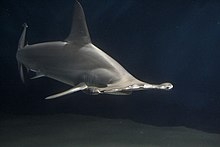Hammerhead Sharks

The hammerhead sharks are a group of sharks that form the family Sphyrnidae, so named for the unusual and distinctive structure of their heads, which are flattened and laterally extended into a "hammer" shape called a cephalofoil. Most hammerhead species are placed in the genus Sphyrna, while the winghead shark is placed in its own genus, Eusphyra. Many different, but not necessarily mutually exclusive, functions have been postulated for the cephalofoil, including sensory reception, manoeuvering, and prey manipulation. The cephalofoil gives the shark superior binocular vision and depth perception.
Hammerheads are found worldwide in warmer waters along coastlines and continental shelves. Unlike most sharks, some hammerhead species usually swim in schools during the day, becoming solitary hunters at night.
Description
The known species range from 0.9 to 6.0 m (2 ft 11 in to 19 ft 8 in) in length and weigh from 3 to 580 kg (6.6 to 1,300 lb). One specimen caught off the Florida coast in 1906 weighed over 680 kg (1,500 lb). They are usually light gray and have a greenish tint. Their bellies are white, which allows them to blend into the background when viewed from below and sneak up to their prey. Their heads have lateral projections that give them a hammer-like shape. While overall similar, this shape differs somewhat between species; examples are: a distinct T-shape in the great hammerhead, a rounded head with a central notch in the scalloped hammerhead, and an unnotched rounded head in the smooth hammerhead.
Hammerheads have disproportionately small mouths compared to other shark species. They are also known to form schools during the day, sometimes in groups over 100. In the evening, like other sharks, they become solitary hunters. National Geographic explains that hammerheads can be found in warm, tropical waters, but during the summer, they participate in a mass migration to search for cooler waters.
Taxonomy and evolution
A hammerhead shark gliding along the sea bed
Since sharks do not have mineralized bones and rarely fossilize, only their teeth are commonly found as fossils. Their closest relatives are the requiem sharks (Carcharinidae). Based on DNA studies and fossils, the ancestor of the hammerheads probably lived in the Early Miocene epoch about 20 million years ago.
Using mitochondrial DNA, a phylogenetic tree of the hammerhead sharks showed the winghead shark as its most basal member. As the winghead shark has proportionately the largest "hammer" of the hammerhead sharks, this suggests that the first ancestral hammerhead sharks also had large hammers.
Cephalofoil
The hammer-like shape of the head may have evolved at least in part to enhance the animal's vision. The positioning of the eyes, mounted on the sides of the shark's distinctive hammer head, allows 360° of vision in the vertical plane, meaning the animals can see above and below them at all times. They also have an increased binocular vision and depth of visual field as a result of the cephalofoil. The shape of the head was previously thought to help the shark find food, aiding in close-quarters maneuverability, and allowing sharp turning movement without losing stability. The unusual structure of its vertebrae, though, has been found to be instrumental in making the turns correctly, more often than the shape of its head, though it would also shift and provide lift. From what is known about the winghead shark, the shape of the hammerhead apparently has to do with an evolved sensory function. Like all sharks, hammerheads have electroreceptory sensory pores called ampullae of Lorenzini. The pores on the shark's head lead to sensory tubes, which detect electric fields generated by other living creatures. By distributing the receptors over a wider area, like a larger radio antenna, hammerheads can sweep for prey more effectively.
- Arts
- Business
- Computers
- Spiele
- Health
- Startseite
- Kids and Teens
- Geld
- News
- Recreation
- Reference
- Regional
- Science
- Shopping
- Society
- Sports
- Бизнес
- Деньги
- Дом
- Досуг
- Здоровье
- Игры
- Искусство
- Источники информации
- Компьютеры
- Наука
- Новости и СМИ
- Общество
- Покупки
- Спорт
- Страны и регионы
- World


